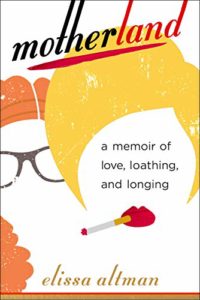
I suppose I’m biased: my people are from Brooklyn. In the early 1900s, my maternal great-grandmother owned a boarding house in Williamsburg, where Caruso stayed one night while passing through town. His manager, Gatti Casazza, invited her into her own parlor where a small concert had been organized without her knowledge. She listened, and then she went back to work.
Her in-law, my grandfather’s mother, owned several buildings in Williamsburg from the late 1800s until her death, and passed them on to my grandfather and his brother, and their wives. When my grandfather died in 1967, my mother and grandmother–rather than risk the regular visitations that ownership of increasingly decrepit real estate necessitated–sold them. Five of them. For less than the price of a tiny studio apartment in a rotten part of the Upper East Side. Today in Williamsburg, the price of a decent loft is now double that of a five bedroom colonial in the Fairfield County town that I live in. Feh.
I did live in Brooklyn once, though. In the early 1990s, after going through a miserable breakup, I lived for eighteen months in my paternal grandparents’ more-or-less empty apartment, on Ocean Parkway and Avenue T. The smell of chicken fat wafted through the rooms and down the halls and hung like ghostly apparitions in every corner. The day that I moved in–two full years after my grandmother had died at 93–an unopened jar of her gefilte fish still sat in the refrigerator. Her clothes, from Klein’s of 14th Street, were still in the closet. A few nights later, when I ordered in a pizza, the next door neighbor opened her door just a crack–enough to see the word “sausage” written on the side of the box as it was being delivered. It was shabbes.
“I hear you’re Henry Altman’s granddaughter?” she asked, through the chain.
“I am,” I said.
She mumbled and slammed the door while I paid for my dinner.
I couldn’t wait to leave.
But a few years ago, the undeniable fact of Brooklyn as New York’s culinary hub started bubbling to the surface, and it gnawed at me a little bit.
“It’s just like Oltrarno,” I told Susan, trying to convince her that we should spend some time there.
“The last time I lived in Brooklyn,” she responded, “someone broke into my car and stole my pillow.”
“Why were you carrying a pillow in your car?” I asked.
“You’re missing the point,” she said.
And she was right. She was intimating that even where she lived in Brooklyn, in Park Slope, on a gorgeous tree-lined street in a gorgeous brownstone, things still weren’t safe.
Fast forward twenty-five years; Brooklyn is now an acknowledged culinary destination. For the first time in years, I wanted to go back and that’s exactly what we did, last weekend. We had two destinations: DUMBO (Down Underneath the Manhattan Bridge Overpass), which used to be an unwalkable, uninhabitable morass of burnt out building shells connected by dangerous streets overlooking various ideal locations for dumping Jimmy Hoffa. And we wanted to go back to Williamsburg, where my family came from.
The day was gorgeous, and our trip in took little more than an hour; Helga, our Scandinavian-but-British-educated GPS took us directly to the Sunday DUMBO location of the Brooklyn Flea, an outdoor flea/vintage market where you can find virtually everything from Eames-era lounge chairs that will set you back a mortgage payment, to the glorious pieces created by Brooklyn ceramicist Alyssa Ettinger, to vintage $45 Tony Lama boots that could make even you feel hip, assuming you are tall, which I am not and never will be. The rumors of Martha sightings abounded, and when she finally did show up with her camera crew, producer, and French bulldog, barely anyone looked up. It’s Brooklyn, and the stand-keepers–including a young woman who was slicing fresh proscuitto and layering it gingerly onto pieces of warm bread that had been dolloped with local, creamy Salvatore ricotta (a great, elemental snack for $3)–were busy. Hipness has nothing to do with it; these people–all of them young and most of them stunning–were working. And when you’re working, time is money.
Alyssa Ettinger’s gorgeous ceramics, at Brooklyn Flea.
Slicing proscuitto, at the Salvatore Ricotta stand.
The last time I had been to 312 Grand Street, where my grandfather owned a furniture store, it was 1967 and I was four years old; my father carried me for fear that I’d slip through the store’s broken floorboards and into the black, Hieronymus Bosch-like Brooklyn abyss of centuries-old Gowanus slime. But I remember well the red-painted doorway, the long, narrow store warmed by a pot bellied stove, and my grandfather lounging on a kilim-covered chaise tucked behind a partition. He came home to Forest Hills only on Friday nights, and the rest of his days and evenings were spent here, at the current site of a bar packed with soused football fans. We parked across the street and walked into Mulholland’s, where dozens of young, testosterone-gushing men were screaming at flat screen televisions while drinking beer. I walked into the back of the bar where the partition had been, and where my grandfather spent his days. The pot-bellied stove was gone, but the tin ceiling was still there, and I closed my eyes and remembered him and the homing pigeons who lived in coops on the roof, and who thought he was their mother.
There’s a lot to be said about a community that was so gravely down on its heels for so many years–you couldn’t walk the streets in Williamsburg in the 1970s and most of the 80s–and that’s come back, while managing to retain some level of its former grittiness. The area has certainly has been the butt of hipster jokes over the years, and it’s true; there is virtually no one in the area under the age of 25. We had lunch at the Roebling Tea Room–a gigantic, baked apple pancake for Susan, and for me, a scoop of whitefish unaccountably sitting atop a white baguette–surrounded by lovely, young hipster people who take their food very, very seriously. There was not one cell phone ringing. Not an iPhone in sight. No one was talking into any electronic device of any kind or reading a Kindle. Everyone was concentrating on the food. And each other.
Before we left town, we drove over to Marlow & Sons, a small, much-heralded market specializing in responsibly-sourced, hand-cut meats, specialty packaged goods you’ll never find anywhere else, local-ish cheeses, cured meats from La Quercia, and chickens with heads and feet. The head butcher came out, and when I told him what I wanted–one pound of the bright red pork shoulder that was sitting in the meat case–he didn’t balk and tell me that a one pound chop would never be enough for two people; he took it out, sliced it lovingly for me, and then gave me the fat that he’d carved away from the meat so that I could make my own lard, should I be inclined to. It was a work of art: the pork was the color of a ruby, which is the color that pork always was until industrial pork farming squeezed the flavor out of it like toothpaste out of a tube and turned it into The Other White Meat. We bought a half pound of La Quercia Speck Americano and a chunk of Pecorino Toscano. And then we went home, back across the Kosciusko Bridge that, when I was a child, used to mean that I was on my way to visit my grandparents in an outer borough that felt stuck in another century and that made me feel just a little bit nervous.
In this Brooklyn, I don’t feel nervous anymore.
Pork shoulder chop, from Marlow & Sons. Doesn’t look like supermarket pork, does it?
Sprinkle lightly with salt and pepper, and sear in a very lightly oiled cast iron pan while oven preheats to 325 degrees F.
Set pork down on sliced onions, and drizzle with half a cup of stock.
Cover, place in oven, and let braise for 35 minutes. This is the result.
Slice against the grain.
Top with onions, and serve with something green.









